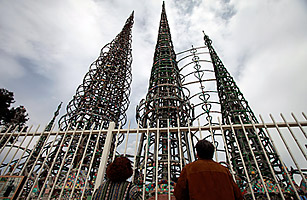
The Watts Towers rise in Los Angeles like a strange evocation of Gaudi’s monumental art nouveau church, the Sagrada Familia, in Barcelona. And to some Angelenos, they are just as sacred — even if the park surrounding the towers is an urban hodgepodge. From one side, a rudimentary concrete amphitheater glowers at the sleek new music center rising on the other. A snarl of barbed wire sits a few feet from a cluster of recently planted palm trees. At the far corner, adjacent to the Towers themselves, a dilapidated chain-link fence draws a perimeter around a gravel lot.
And on that chain-linked lot will come the next project to vex the lovers of the towers: a $350,000 skateboard park funded by the Tony Hawk Foundation and the Annenberg Foundation. L.A. City Councilwoman Janice Hahn hopes the park will provide a positive outlet for kids, and has met with local residents over the last two years to garner support for her plan. But some members of the community are outraged at the idea an athletic facility in the shadow of their iconic Towers.
The Watts Towers were the creation of Italian-immigrant artist Simon Rodia, who bought the land in the 1920s and spent most of the next 30 years building the rebar-and-concrete structures and covering them in shimmering mosaics. They’re a beacon of art in a neighborhood otherwise known for the riots of 1965 and gang violence that peaked in the late 1980s but continues today. “They’re a national arts treasure and a cultural hub for musicians and visual artists,” local artist Dominique Moody says.
Moody and other members of a small community of artists affiliated with the Watts Towers Arts Center, which was established on the grounds in 1964, consider the Towers sacrosanct. “This area is called ‘The Cultural Crescent’,” she says, referring to the official name of the park, The Watts Towers Cultural Crescent. “A skateboard park doesn’t fit with that.” Edward Landler, a filmmaker who made a 2006 documentary on Rodia called I Build the Tower, agrees. “It’s like putting a skateboard park in front of the Taj Mahal,” he says.
But Moody’s fears run deeper than semantics. She worries that the skate park will so drastically change the environment around the Towers as to jeopardize Rodia’s artistic legacy. “It’s a detriment to the expression of Simon Rodia as an artist,” she tells TIME.
Other residents have a more practical concern: safety. They worry that the Towers, which have so far been immune to gang activity and the drug trade, could become dangerous. “Everybody knows it’s going to bring unwanted attention, tagging, gang issues and an open space for drug dealing,” says Wilma Frazier, a Watts resident whose 11-year-old daughter frequents the arts center.
Councilwoman Hahn says she chose the Towers as the site for the skate park specifically because they’re in a gang-neutral zone. “These kids are bombarded from the time they leave home till after school by gang members and drug dealers who are trying to get their attention,” she tells TIME. “We worked very closely with the LAPD and the Watts Gang Task Force, and they felt this was a good, gang-neutral spot.”
Supporters of the project point to the positive experience of San Pedro, 15 miles south of Watts and also within Hahn’s district. In 2008, San Pedro residents finished work on a skate park they funded with donations, including $5,000 from the Tony Hawk Foundation. Says Brandon Zankich, owner of an area skateboarding shop called Sunken City Skates, “It used to be nothing but crackheads hanging out in their cars. But after they built the skate park, it flushed away all the negative energy there.”
The Watts Towers Skate Park will be the 481st skate park in the nation to receive grant money from the Tony Hawk Foundation in the nine years since professional skateboarder Tony Hawk started financing parks in low-income communities. Input from local skaters has been integral to the Tony Hawk Foundation’s approach, and the Watts park is no different. “We went out and interviewed the parents and kids in the [housing] projects nearby,” says Miki Vucovich, executive director of the foundation. What Vucovich and his team discovered is that there were existing skate parks in those projects, but they weren’t any good.
A challenging skate park is a key factor in maintaining skaters’ interest if they’re going to use the sport as a means for financial advancement — which Hahn thinks they will. “These kids have heroes, whether it’s Tony Hawk or P Rod [Paul Rodriguez, Jr.], who have made a career out of skateboarding and are making millions of dollars,” Hahn says. “They can look at [it] as a ticket for the rest of their lives.” In San Pedro, some skaters are doing just that. According to Zankich, half a dozen kids from ages nine through 20 who honed their skills at the San Pedro skate park have gotten sponsorship deals.
As of now, the skateboarders who live in the vicinity of the Towers must travel into the gang-plagued housing projects to practice their sport. A group of eight teenagers hanging out in the amphitheater next to the Towers after school on a recent afternoon nodded their heads enthusiastically when asked what they thought of the idea of putting in a skateboard park next to the modernist monument. Brayan Sosa, a 14-year-old with shaggy black hair, says it would allow him to skateboard more. Enrique Millanes, also 14, agrees. “It’ll help keep people out of trouble,” he says.
The Tony Hawk Foundation’s Vucovich tries to put everything into perspective, hoping it will help everyone get along. “The Towers represent Watts’ creative history,” he says, “and the kids on their skateboards represent Watts’ creative future.”
See a video of skate culture in Kabul.
See photos of Tony Hawk.